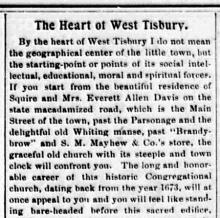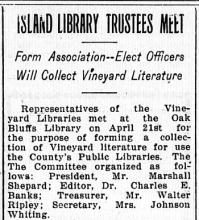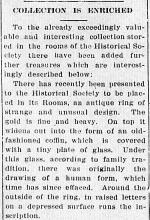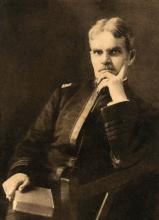To the already exceedingly valuable and interesting collection stored in the rooms of the Historical Society there have been added further treasures which are interestingly described below:
There has recently been presented to the Historical Society to be placed in its Rooms, an antique ring of strange and unusual design. The gold is fine and heavy. On top it widens out into the form of an old-fashioned coffin, which is covered with a tiny plate of glass. Under this glass, according to family tradition, there was originally the drawing of a human form, which time has since effaced. Around the outside of the ring, in raised letters on a depressed surface runs the inscription.
R. Hearsey: Ob: 4: Oct.: 1773: Ae: 23.
After a century and a half the letters are perfectly clear and distinct, and the inscription is easily read. The gold at the back of the seal is corrugated or ribbed, similar to a scallop shell. There is another legend to the effect that the glass covered a lock of hair instead of the picture referred to, but the story as told, is that given and believed by the family in which it was an heirloom. Possibly after the fading of the picture, a tiny lock of hair may have taken its place. Such could easily have been the case.
The ring belonged to the Reverend Joseph Thaxter, better known perhaps as Parson Thaxter, pastor of the church in Edgartown, and first chaplain of the American Revolution.
In 1773, while still a resident of his native town of Hingham, he went to Maine on a mission to preach. At that time he was engaged to be married to a young lady named Rachel Hearsey, who was also a resident of Hingham. During his absence she was taken critically ill. There was neither telegraph nor telephone in those days to carry the message, and letters travelled slowly, and before the tidings of her illness could reach him, she died. Here again the stories differ slightly, the family tradition being that the grief stricken lover had the mourning ring made and wore it in her memory, the other story stating that it was a gift to him from members of her family. In either case no doubt, the design was selected as a fitting expression of the depth of his sorrow.
After Parson Thaxter came to Edgartown, and while occupying the old Thaxter homestead, since torn down, the ring unaccountably disappeared. All search was unavailing, and the mystery was still unsolved when Mr. Thaxter died. Many years afterward, in making repairs, one of the chimneys of the old house was taken down, and there lodged among the bricks, was the missing ring. It is supposed that for some reason it may have been placed temporarily in the cupboard beside the chimney, and slipping through a crack, was caught in the brickwork.
Eventually it came into the possession of Mrs. Susan Coombs, grand-daughter of Parson Thaxter, who gave it to her nephew, Mr. John Osborn of Boston, as a memento of his great-grandfather. So the little ring travelled to Boston where it remained until the death of Mr. Osborn. The Mrs. Osborn feeling that its rightful place was it its old home, presented it to the Historical Society to be placed with other Thaxter relics.
Another recent and valuable addition to the Historical Collection are two beautiful and interesting portraits in oil, the gift of Miss Martha Daggett of Vineyard Haven.
First let me introduce to you Captain Timothy Daggett, born in Edgartown, March 28, 1768. Smooth face, ruddy complexion, grey hair brushed over the forehead in a “bang,” then “bobbed” around the head, pleasant blue eyes, and well formed mouth with corners slightly upturned, the chin deeply cleft. The right hand is lightly thrust into the double breasted vest, and at the wrist, from the slightly open sleeve, flows a narrow white ruffle. The white lawn “neckerchief” is warn high around the throat, with bow and flowing ends that reach to the vest.
The other portrait is that of his son, William Franklin Daggett, born in Edgartown, March, 1808. There is the same smiling, somewhat whimsical mouth with its uplifted corners, and the cleft chin below, but the hair, heavy and abundant, is dark, brushed away from the forehead, and brought forward over the ears, the face is smooth except for short side whiskers, thin, and patrician. The coat is dark, opening over a stiffly starched shirt bosom, while the black “neckerchief” is fully three inches broad, with just a narrow line of white collar above. Two handsome and gallant gentlemen.
There has also been placed among the souvenirs of the War of the Rebellion, battle flag, soiled and torn, the gift of Mr. Harry A. Norton. It was carried at the battle of Balls Bluff, Virginia, Oct. 21, 1861, by George Ferguson of Amsterdam, N.Y. The pole is of heavy southern bamboo, and at the top, nailed on, is a small cross piece of rough wood. We can only surmise that the original pole may have been shot away.
There are many still living in Edgartown, who recalling the stress and anxiety of those days, will feel the appeal of the old battle scarred flag, but remembering too, the conflict where it played its part, will be thankful that it cannot speak to tell its story.
J.S.N.











Comments